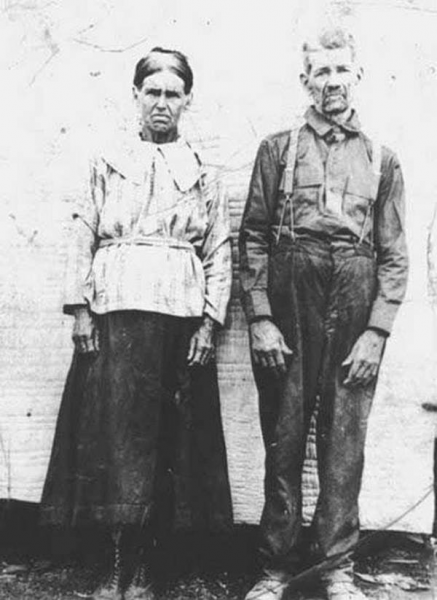The Blue-Skinned Fugates of Eastern Kentucky.
Bobby Vinton sang “Blue on Blue”. Gershwin wrote “Rhapsody in Blue”. Texas has bluebonnets as the state flower and Blue Bell Ice Cream. Duke University has the Blue Devils. Kentucky has … blue people?
Way back in 1820, a French immigrant named Martin Fugate settled in the mining country of eastern Kentucky in a small town called Troublesome Creek.
Here, he planned to start a family with his new bride, a red-haired, pale woman named Elizabeth Smith. But Fugate had one characteristic that made him a little different than the other men in the area—he had blue skin.
The newlyweds went on to have seven children, including four of them with the same blue skin as their father.
There were no obvious physical problems caused by their skin color, and most of the clan lived into their eighties and nineties. At the time nothing was known of the condition that caused the blue skin. The artist Walt Spitzmiller in fact painted the portrait of the Fugate family (see Walt Spitzmiller Fine Art)

IFLScience explains that the blue coloring was caused by a genetic disorder called methemoglobinemia. While the same blue skin can be caused by exposure to certain substances like benzocaine, in this case, it was caused by faulty genetics, resulting in too much methemoglobin, a type of red blood cell, or hemoglobin. The lead image
According to Medlineplus, an NIH website, in this disorder, hemoglobin does carry oxygen, but does not effectively release it to skin and tissues so they maintain the normal pink coloring.
Passing the recessive gene on to children requires that each parent carry the gene. So, by a quirk of fate, Fugate picked a wife with the same recessive gene he carried, passing it on to their children.
Based on genetic science, with each of them carrying the gene, their children would have a one in four chance of inheriting the color.
So now the population of Troublesome Creek had grown from one to five blue people. Troublesome Creek was a small, isolated town, with no roads or railroads to connect it to surrounding areas.
Because of their disorder, and the resulting embarrassment and discrimination, the Fugates tended to isolate themselves, which indirectly perpetuated the problem.
Because of their shame, the avoidance of the other townspeople, and the overall isolation of the town, the gene pool was fairly restricted.
The Fugates had several instances of inter-marrying within their same bloodline, thereby spreading the disorder and increasing the likelihood of two people carrying the recessive gene.
One of Fugate’s children married his aunt, and there were several situations of cousins marrying cousins in their family tree. In those cases where they married outside the family, the genetics still stayed tight, and others began to give birth to blue children.
In the 1960s, Dr. Madison Cawein arrived in the town, having heard the rumors of blue skinned people and wanting to investigate further.
He teamed up with a local nurse, Ruth Pendergrass, who had provided medical attention to a blue-skinned woman previously.
They met several members and descendants of the original Fugate tribe and eventually isolated the blue color to the genetic disorder methemoglobinemia.
Surprisingly, there was a simple fix, even though it was a counter-intuitive one—injecting the people with methylene blue dye, which turned the skin a normal pink. This was a temporary solution, however, and had to be re-injected to keep the effect.
In one last hurrah for the gene, Benjamin Stacy, a descendent of the Fugate family, was born in the 1970s, suffering from the same blue-skinned malady.
His appearance so alarmed the doctors that he was immediately transferred to an emergency facility for treatment, but his grandmother passed on the information about the family history, and Benjamin did test positive for the disorder.
He must have had only a single instance of the gene, however, as the color eventually faded away and he now lives a normal, pink-skinned life in Alaska.
Given the modern improvements in transportation and mobility, and the dilution of the gene pool of people with methemoglobinemia, it’s fairly likely that we have seen the last of blue-skinned people.
Discovered 25,000-Year-Old Hut Made From Mammoth Bones
But there is still the chance it could happen again—maybe once in a blue moon.





